Hillside House invertebrates species list
Listed below are miscellaneous invertebrate species recorded at Hillside House from October 2013 onwards.
(NA) indicates that the relevant name needs to be searched out.
Help from entomologists to extend the list would be very welcome!
Class: Arachnida (Spiders)
| species | status/comments |
|---|---|
| Oonops sp. | Family Oonopidae. Present in Hillside House, species needs checking (handlens or microscope required). |
| Dysdera sp. (woodlouse spider) | Apparently absent. [One found on flint wall of Helhoughton church May 2018, prob. D. crocata.]. |
| Harpactea hombergi | Family Dysderidae. In the shed near Hillside House |
| Segestria senoculata | Family Dysderidae. Previously thought to be absent from plot as suitable old brick walls are missing. One found inside breeze block 02/11/2016 during the dismantling of a garden wall.. |
| Scytodes thoracica (spitting spider) | Family Scytodidae. Apparently absent. |
| Pholcus phalangeoides (daddy-longlegs spider) | Family Pholcidae. Abundant in Hillside House. |
| Salticus scenicus (zebra spider) |  Family Salticidae. On external walls round the house and shed, also on the log-stack built in 2016. Picture shows the enormous forward-facing median pair of eyes. |
| Hypositticus pubescens | 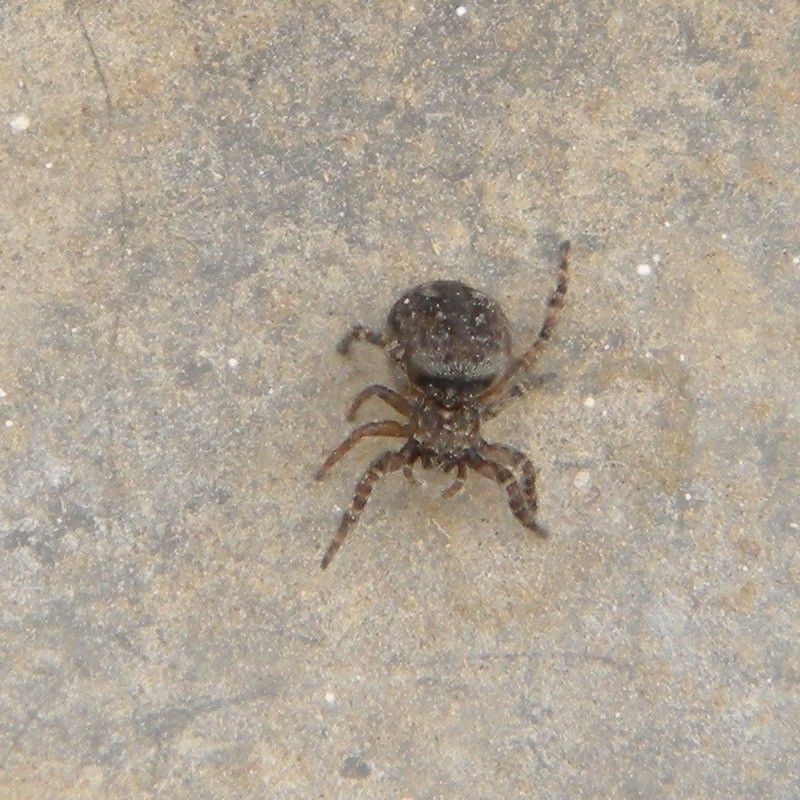 Family Salticidae. First found on west-facing external wall of Hillside House July 2022, during very hot weather. Males and females present, total 8+. Now also found in subsequent summers and seems to be well-established on walls on the north end of the house. |
| Pardosa sp. (wolf spider) | Family Lycosidae. Abundant in spring on short grass by pond. |
| Trochosa sp. | Family Lycosidae. One being hauled by pompilid wasp on patio. |
| Pisaura mirabilis |  Family Pisauridae. Quite common in various places, by the pond, on the meadow, in short to medium length grass etc. |
| Drassodes sp. | Family Gnaphosidae. Needs checking. |
| Scotophaeus blackwalli (“mouse spider”) | Family Gnaphosidae: Herpyllus in Bristowe. Present in Hillside House. |
| Agelena labyrinthica | Family Agelenidae. (A house spider relative). Present on the meadow and now in the garden area near Hillside House, perhaps reflecting changes in maintenance methods (intervals between grass cutting sessions increased). [Was also very common in places on old grazing near the plot, on creeping thistle, before grazing was renovated.] |
| Tegenaria domestica | Family Agelenidae. House spider. Present in Hillside House and in the shed. |
| Amaurobius ferox | Family Agelenidae. (Ciniflo ferox.) One found in breeze block rubble 03/11/2016 during the dismantling of a garden wall. |
| Amaurobius similis | Family Agelenidae. (Synonym Ciniflo similis). Numerous, in the shed and elsewhere. |
| Steatoda bipunctata ("false widow") | Family Theridiidae (comb-footed spiders). In and around the shed, Hillside House. |
| Enoplognatha ovata (comb-footed spider) | 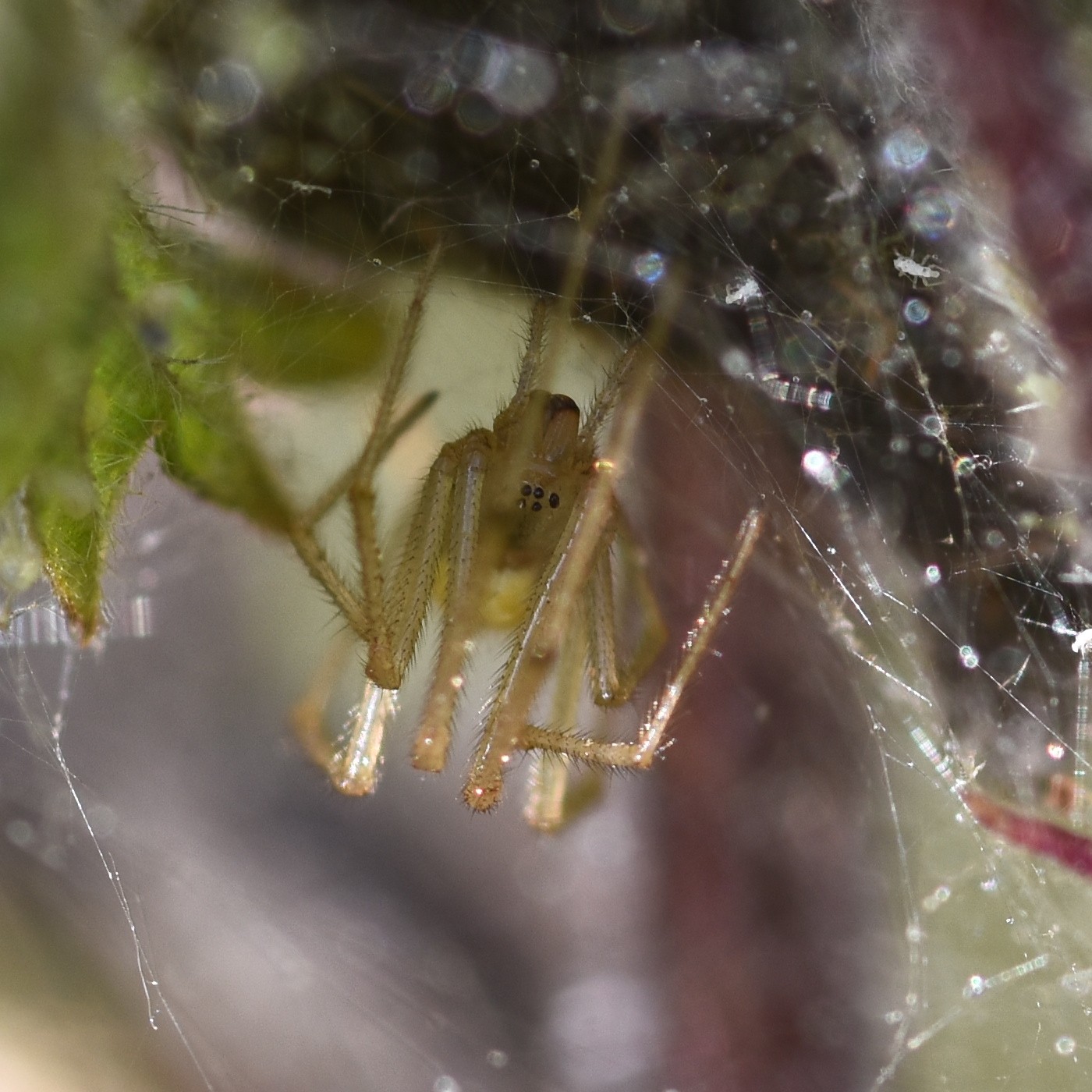 Family Theridiidae (comb-footed spiders). On creeping thistle flowers 2021-07-24. Picture shows a female inside her tent refuge on hornbeam square (a grassy patch near the shed). |
| Tetragnatha spp. | Family Tetragnathidae. Found on the meadow. Also, now, on the young yew hedges. |
| Pachygnatha sp. | Family Tetragnathidae ("large-jawed" orb-spinners). Found in 2020 in several places by Hillside House. From size, probably P. clercki (Bristowe p.255 says length is 6mm for this species) or perhaps P. degeeri. Abdomen on one or two individuals strongly patterned, noticeably diamond-shaped. Cephalothorax dark. Bristowe says this genus has abandoned web-spinning, except in the young spiderlings. The adults apparently actively search for prey (the 'vagabond' lifestyle). Surprisingly, modern phylogenies suggest that orbweb-spinning is an ancient trait, abandoned by many modern groups (among the 'RTA' clade, which includes wolf spiders and jumping spiders). |
| Metellina segmentata | Family Tetragnathidae ("large-jawed" orb-spinners). An orb-spinner. Formerly Meta segmentata. Probably this species. By 2024 this spider could fairly be described as abundant on the Hillside House plot. In 2018, had become quite numerous on yew hedges and shrubby plants. This species is very close to M. mengei and various sources say they can only reliably be separated by microscopic examination of epigyne or male palps (or spines on male legs). On the pictured spider, seen in late summer, the dark stripe on the underside of the abdomen seems to extend beyond (in front of) the epigyne and epigastric groove. |
| Larinioides cornutus | 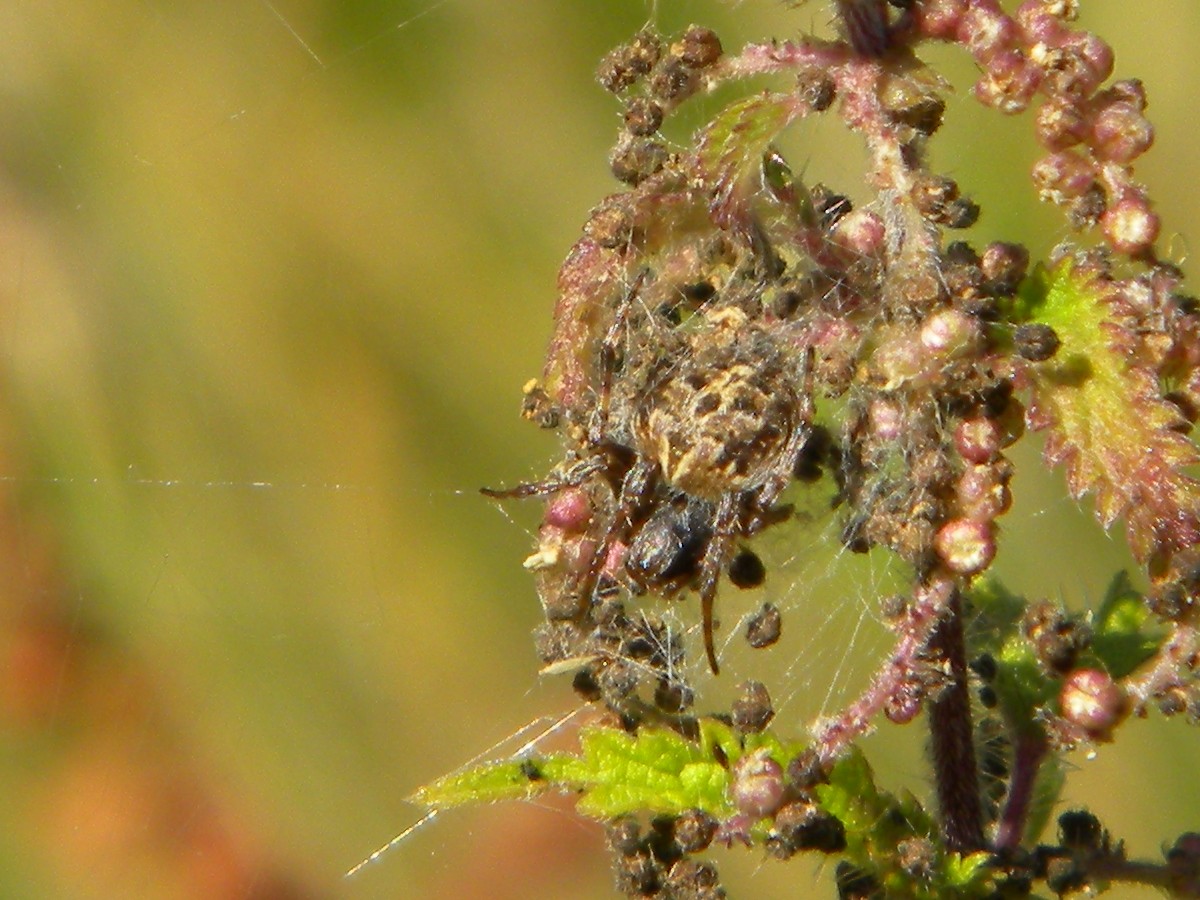 Family Argiopidae. (Formerly, in e.g. Bristowe or Locket & Millidge, Araneus cornutus). First record 2024. A female on web at top of nettle plant July 2024. Probably others near main pond, too small to be certain in the field. [Present in 1970s on Bungay (Outney) Common.] |
| Nuctenea umbratica | Family Argiopidae. (Formerly Araneus umbraticus). Resident in the shed roof. In woodwork of a garden seat August 2016. Also in woodwork supporting planted poplar trees August 2019. [Also, in split stem of goat willow near Hindolveston 2019, perhaps the archaic habitat type.] |
| Araneus diadematus (garden spider) | 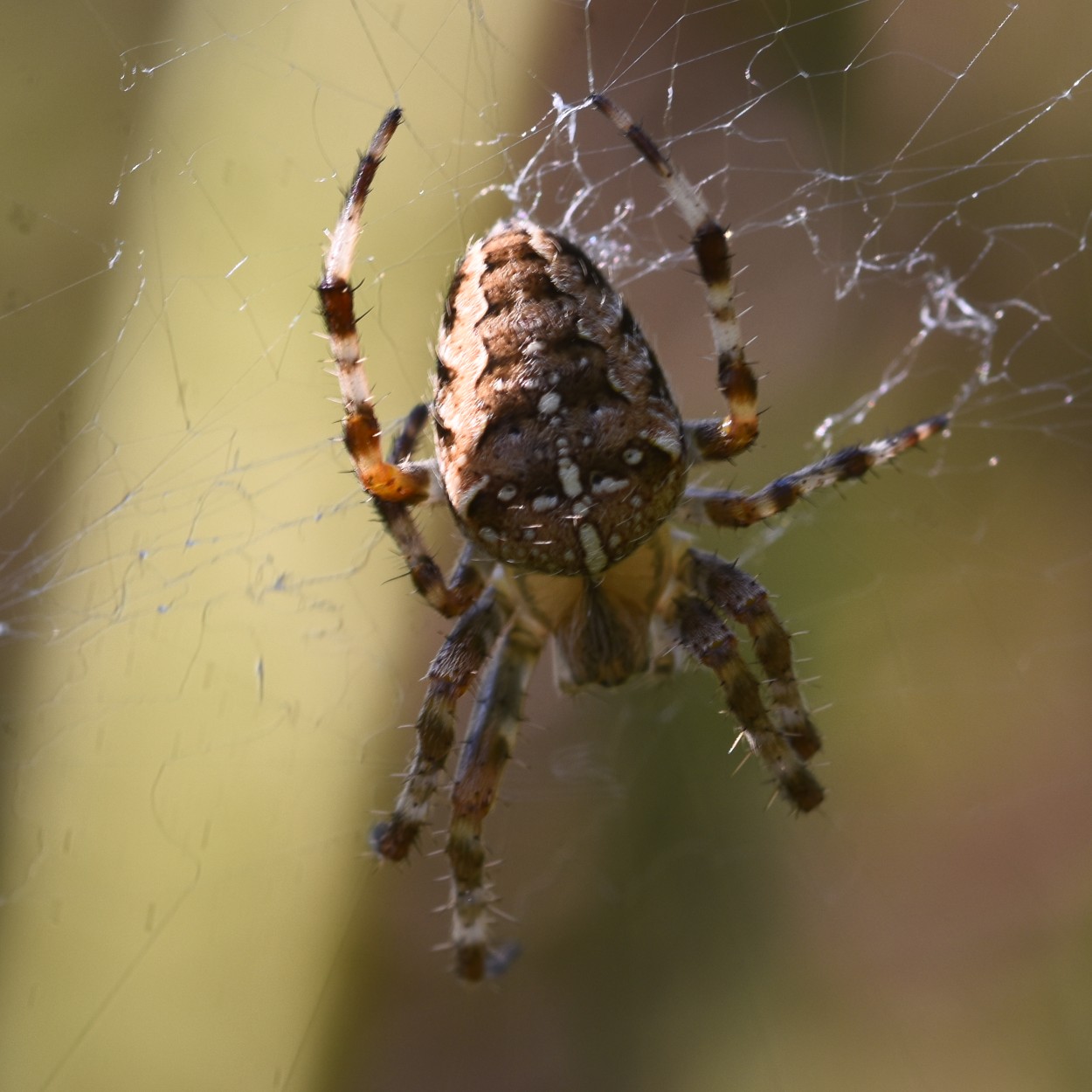 Family Argiopidae. Present, at first in rather small numbers, now increasing. Webs are on thistles, nettles etc, some of which are left to grow now -- previously they were probably removed by mowing. Counts of this and other Araneus species might be useful as a proxy for the background numbers of flying insects. The species is (relatively) large, easy to recognise and still reasonably common. |
| Araneus quadratus | 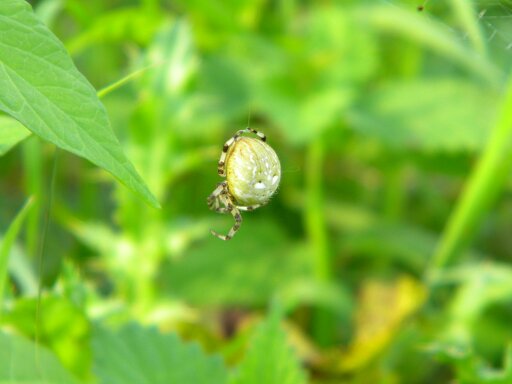 Family Argiopidae. Resident on the meadow in small numbers. In August 2019, a few were present in the triangular grassy or thistly area just north of the main pond. Older records include 1) one within the poplar planting area October 2018; 2) some on grassy area just south of main pond; 3) a few found on the meadow in autumn 2014. [Present on old grazing fields east of South Raynham church.] |
| Araneus marmoreus pyramidatus |  Family Argiopidae. By 2020, increasingly found round the plot on tallish herbs (thistles, docks etc) in late summer. First recorded close to the main pond in tall reedy rank vegetation, autumn 2016 -- a female inside her tent. Also on spear thistles on grassy areas just south of, and just north of, the main pond, August 2019. |
| Araniella cucurbitina | Family Argiopidae. Formerly Araneus cucurbitinus. On pine by shed, 2016. On yew hedge May 2020. |
| Zygiella atrica | Family Argiopidae. Needs checking. A Zygiella species is present on the structure of the shed. |
| Zygiella x-notata | Family Argiopidae. Needs checking. A Zygiella species is present on window frames all round Hillside House. |
| Mangora acalypha (“cricket-bat spider”) |  Family Argiopidae. Tentatively identified in 2021, on orb-web, on Juncus effusus by poplars A03 and A13, 2021-07-12. Confirmed in 2024, see picture. Present in at least two places (meadow MSE and grassy / thistly area just south of main pond). |
| Linyphia triangularis |  Family Linyphiidae. One of the larger species of Linyphiid spiders and often found upside down under its web on hedges and low vegetation. At Hillside House, at first, seemed strangely scarce or even absent. Since the planting of the yew hedges in 2013, numbers have increased and this species now probably figures in the diet of some passerine birds (e.g. coal tit) in Hillside House garden. |
| Erigone dentipalpis (money-spider) | Family Linyphiidae. (Probably this species). Likely to land on anyone sitting outside by Hillside House in the summer months. One of the many Linyphiid species likely to tbe present on the plot, but correct identification requires microscopic examination. |
| Tapinopa longidens | Family Linyphiidae. (Probably this species). Low webs are abundant on cut grass round the plot. (With no superstructure, said to glisten like snail trails.) |
Class: Insecta (Insects)
| species | status/comments |
|---|---|
| Ephemera danica (“mayfly”) | Order Ephemeroptera: Family Ephemeridae (mayflies). Appears erratically on Hillside House plot from time to time. Sometimes reaches the house (150 metres from the Carr Stream). |
| Calopteryx splendens (banded agrion) | Order Odonata: Family Calopterigidae (demoiselles). Present fairly reliably near main pond and on meadow. First records from Hillside House garden at times in 2016. |
| Pyrrhosoma nymphula (large red damselfly) | Order Odonata: Family Coenagrionidae (damselflies). On the Carr Stream 2017, probably first record for the plot. On main pond 2024 after pond renovation work in autumn 2023. |
| Coenagrion puella (azure damselfly) | 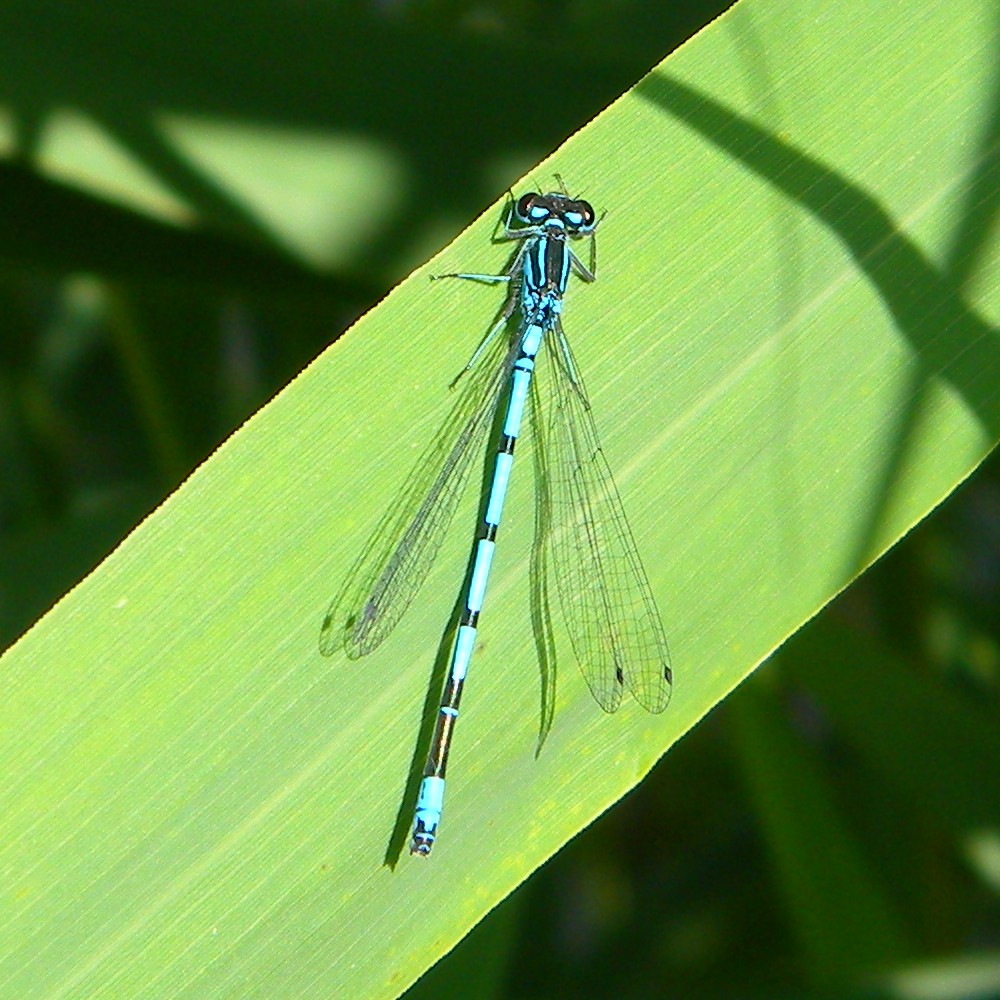 Order Odonata: Family Coenagrionidae (damselflies). On main pond 2024 after pond renovation work in autumn 2023. Tandem pairs ovipositing in floating algae and weeds. |
| Aeshna cyanea (southern hawker) | Order Odonata. Thought now to be reliably present as a breeder, mainly on main pond, no ovopositing seen yet. First year of steady records was apparently 2016, with one holding territory on the main pond. Had been seen occasionally, but not reliably, in previous years, so probable breeding from 2016 onwards may reflect improved condition of the main pond after reduction and pruning of fringing trees. As yet has not been seen much round the new pond in the NW corner of the meadow. |
| Aeshna mixta (migrant hawker) | 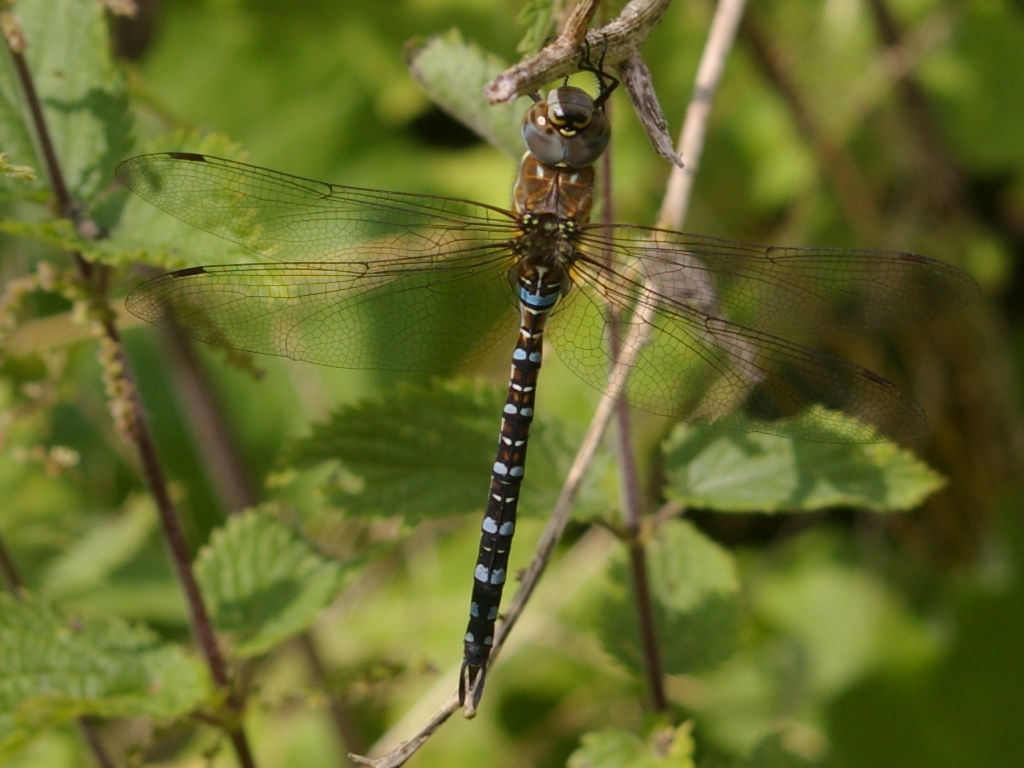 Order Odonata. Both sexes recorded 2021, and probably breeds on plot. First recorded in garden on several days late summer 2015 and 2016. |
| Aeshna grandis (brown hawker) | Order Odonata. Over grassy areas and the pond at times in 2018. Odd records in other years. |
| Sympetrum striolatum (common darter) | 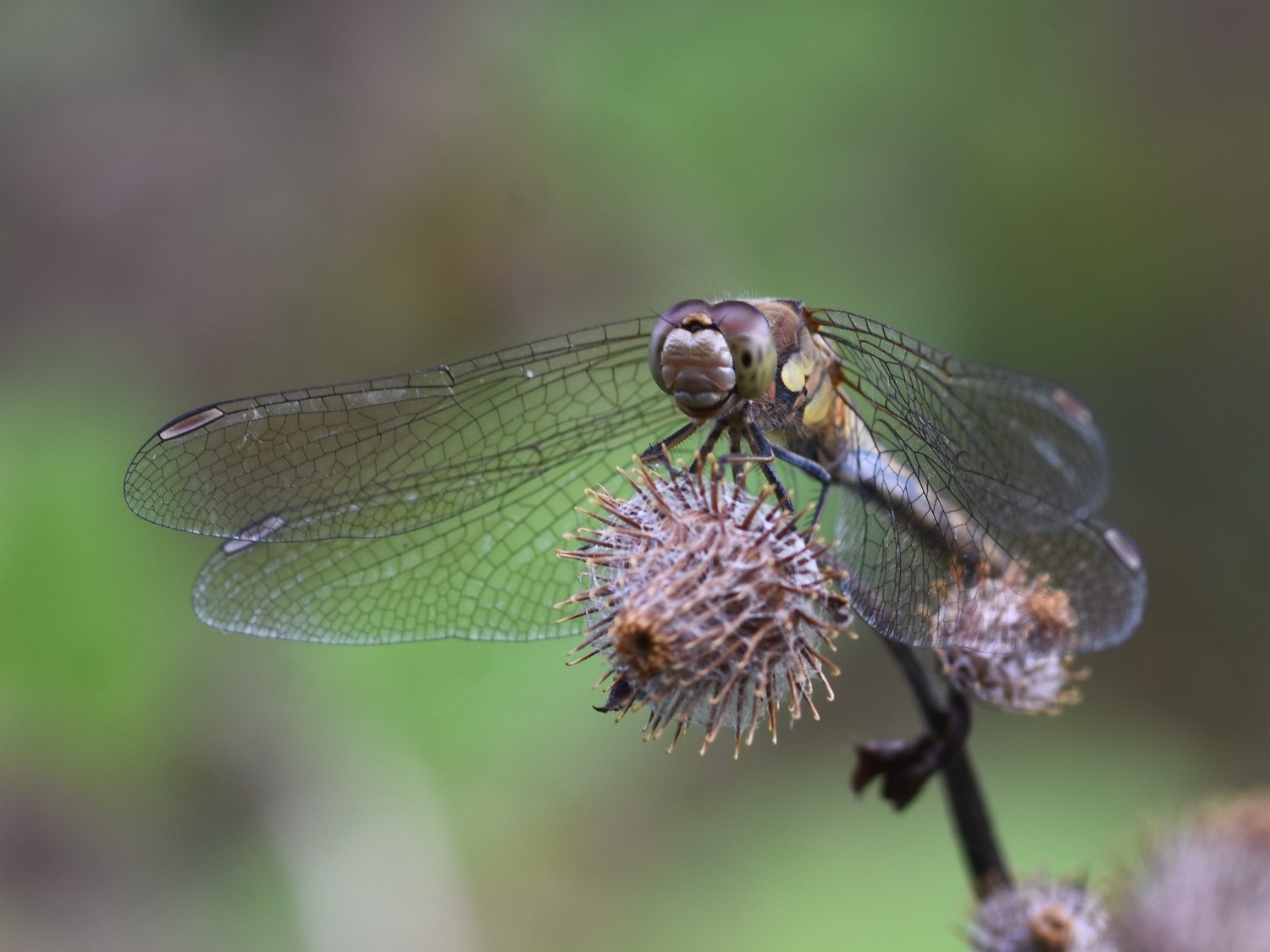 Order Odonata. Often to be seen perching on low herbaceous growth, fences, etc. Increasing and now almost abundant. Perhaps 50 to 100 present over the plot on some days in 2024. Tandem pairs on the main pond in 2024. Image shows black line on face ends at top of frons, doesn’t extend downwards (see Freshwater Life by Greenhalgh & Ovenden). |
| Sympetrum sanguineum (ruddy darter) | Order Odonata. First recorded in summer 2017. Several territories along the track near western edge of meadow, also one or two near the pond. Scarcer than common darter, though apparently increasing its range in UK in recent years. |
| Libellula quadrimaculata (four-spotted chaser) | Order Odonata. On main pond on several days in 2024. First recorded 2017 near Carr Stream. |
| Libellula depressa (broad-bodied chaser) | Order Odonata. Two (male, female) main pond 2024-06-06. At least two records 2021. One holding territory by shed, May 2020. Also present in 2019 (21/05/2019). Arrived 2018 after the new pond was dug, meadow NW. |
| Tetrix undulata (common ground hopper) | Order Orthoptera: Family Tetrigidae (ground hoppers). One found near main pond June 2024. |
| Acanthosoma haemorrhoidale (hawthorn shieldbug) | 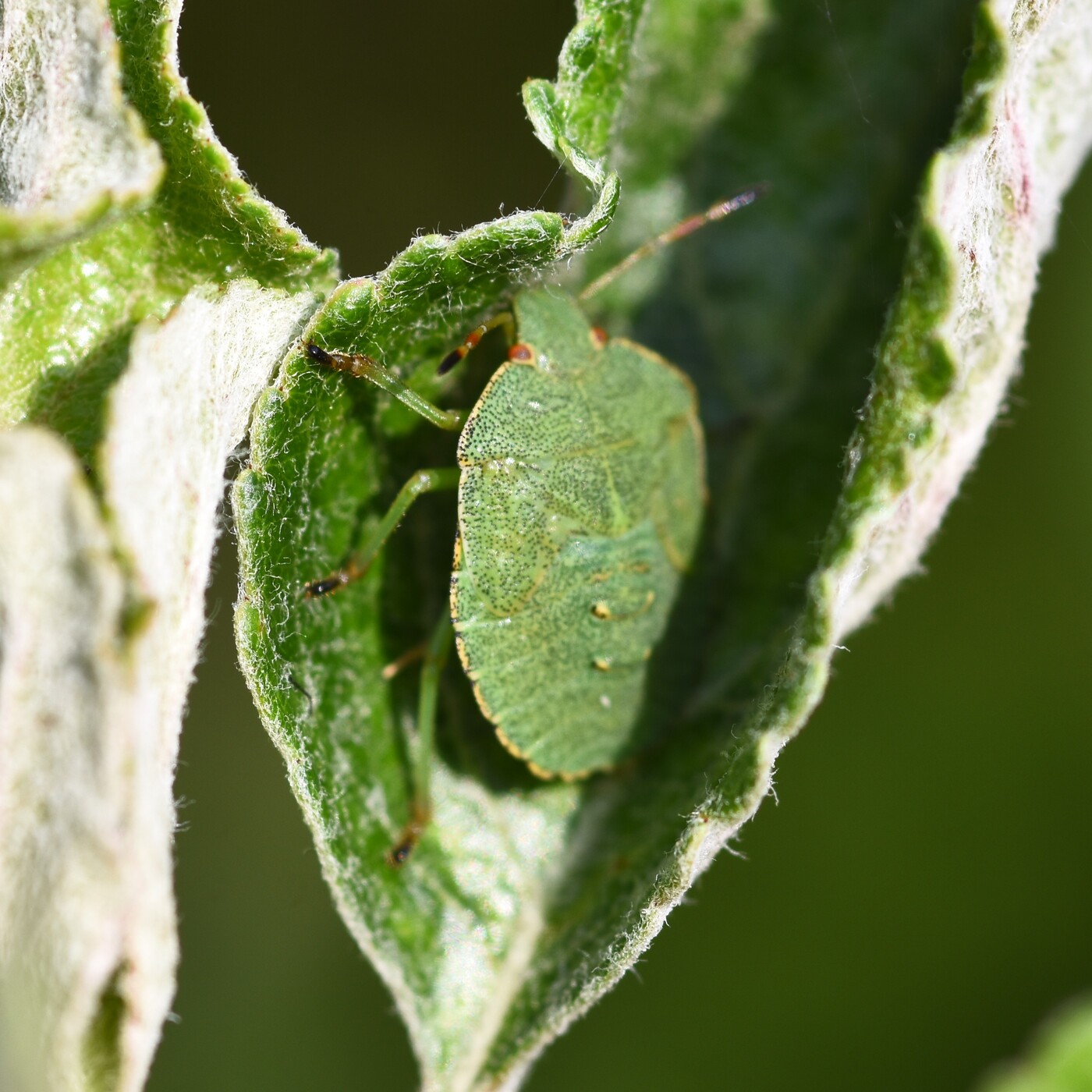 Order Hemiptera: suborder Heteroptera. Family Acanthosomidae. Tentatively identified from British Bugs website. Also mentioned in Chinery. One on a Cox’s apple tree at Hillside House, August 2024. Website pictures indicate this example to be mid-instar. Chinery says this species feeds on leaves, though the adults eat hawthorn fruit. |
| Coreus marginatus | Order Hemiptera: Family Coreidae (“squash bugs”). In various places round Hillside House plot 2024. Record accepted by irecord. |
| Himacerus mirmicoides (ant damsel bug) | Order Hemiptera: Family Nabidae. Image shows a nymph on a burdock seed-head August 2024. According to NatureSpot, this species is sually found on the ground. |
| Nabis limbatus (marsh damsel bug) | Order Hemiptera. (Dolichonabis limbatus). Tentatively identified from Chinery and web images. One on the windows of Hillside House, July 2021. A predatory bug, feeding on other insects, using mantis-like front legs. (Some relatives engage in “traumatic insemination”.) |
| Pentatoma rufipes (forest bug) | Order Hemiptera. Round the plot generally, in fairly small numbers. |
| Cercopis vulnerata | Order Hemiptera. A bright red and black froghopper-like bug. Seen near Carr Stream 2017-05-13, also near Hillside House May 2020. |
| Tuberolachnus salignus (giant willow aphid) | Order Hemiptera. An aphid found in large numbers on youngish regrowth of Salix trees (probably S. cinerea) by the main pond in autumn 2019. Identified by large size (5 mm body length), greyish coloration and characteristic 'horn' on dorsal side of abdomen. |
| Tetraneura ulmi (elm sack gall aphid) | Order Hemiptera. Many galls on leaves of wych elm Ulmus glabra by Hillside House 2022. This was soon after the tree was pruned back. Identified by anonymous expert, record submitted to irecord. In 2024 these galls were virtually absent on the same tree. |
| Panorpa communis (scorpion-fly) | Order Mecoptera (scorpion-flies): Family Panorpidae. To be seen on low vegetation round Hillside House plot. Species P. germanica is very similar but can be distinguished by details of male or female genitalia (NatureSpot). |
| Thymelicus sylvestris (small skipper) | butterflies (Hesperiidae). Seen on meadow and grassy areas, fairly common. |
| Celastrina argiolus (holly blue) | butterflies (Lycaenidae). Often seen on or near the laurel hedge and on the ivy 'hedge'. |
| Polyommatus icarus (common blue) | butterflies (Lycaenidae). Records need checking. |
| Lycaena phlaeus (small copper) | Order Lepidoptera: butterflies (Lycaenidae). At least 2 in 2021 (MSW, also near Hillside House). |
| Aricia agestis (brown argus) | butterflies (Lycaenidae). First record 2021-08-02, on cranesbill (or storksbill) on concrete track by Hillside House. |
| Satyrium w-album (white-letter hairstreak) | butterflies (Lycaenidae). In Hillside House garden on several days 2015. This species is associated with elm. |
| Favonius quercus (purple hairstreak) | butterflies (Lycaenidae). A female by the main pond on low vegetation (burdock etc), apparently drinking dew off leaves 2020-07-12. Identified from images on the Butterfly Conservation website. This species is closely associated with oak, hence the scientific name. (Black hairstreak is found on blackthorn). |
| Pararge aegeria (speckled wood) | butterflies (Nymphalidae). In Hillside House garden, frequent. |
| Aphantopus hyperantus (ringlet) | butterflies (Nymphalidae). One of the commonest butterflies on the Hillside House plot during June and July. |
| Maniola jurtina (meadow brown) | Order Lepidoptera: butterflies (Nymphalidae). Common on the grassy part of Hillside House garden and on the meadow. |
| Pyronia tithonus (gatekeeper) |  butterflies (Nymphalidae). In Hillside House garden, not abundant but not scarce. |
| Argynnis paphia (silver-washed fritillary) |  butterflies (Nymphalidae). A somewhat worn adult on burdock patch (Arctium minus complex) by big oak July 2022. Record submitted to irecord. On buddleia 2016 by the shed. The food plant of the larvae is Viola riviniana. Although V. odorata is abundant in some places round the plot, V. riviniana has not been found here yet. |
| Polygonia c-album (comma) | 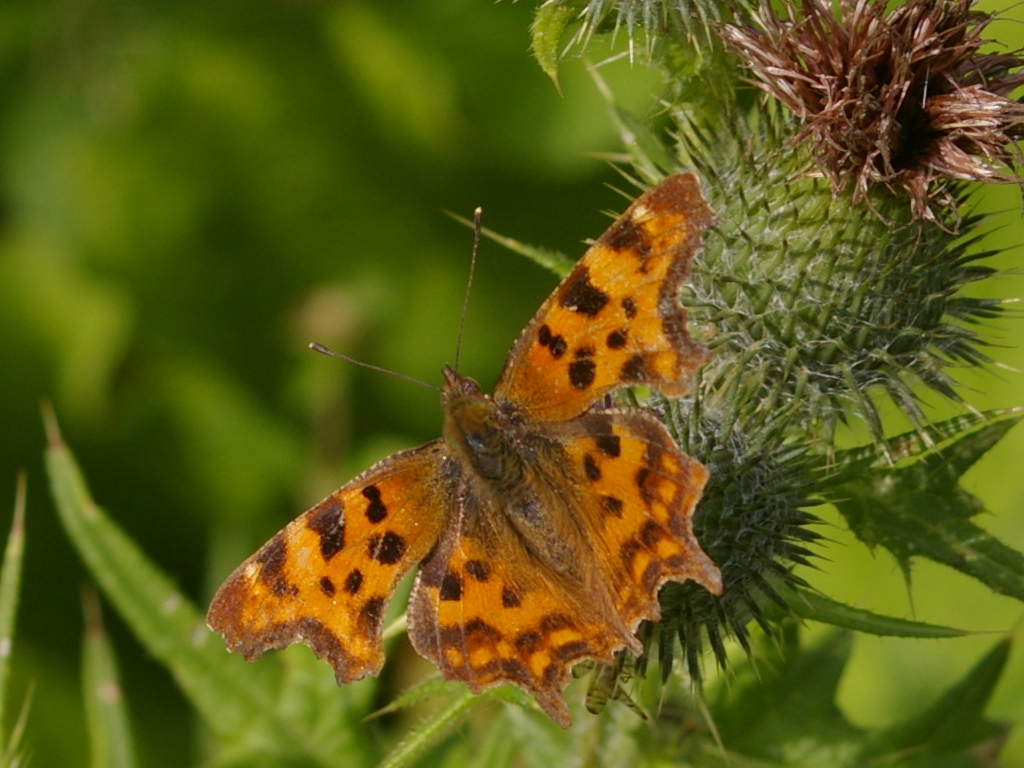 butterflies (Nymphalidae). One of the more numerous butterflies in Hillside House garden, active well into autumn. Larvae feed on nettles. |
| Vanessa cardui (painted lady) | butterflies (Nymphalidae). Recently (2021) reliably present during summer months, often on thistles by main pond. |
| Vanessa atalanta (red admiral) | butterflies (Nymphalidae). In Hillside House garden. One of several Nymphalidae where the larvae feed on nettles, which are plentiful in Hillside House garden. |
| Inachis io (peacock) | butterflies (Nymphalidae). In Hillside House garden. Larvae feed on nettles. |
| Aglais urticae (small tortoiseshell) | butterflies (Nymphalidae). In Hillside House garden. Larvae feed on nettles. |
| Anthocharis cardamines (orangetip) | butterflies (Pieridae). In Hillside House garden in spring, still fairly numerous. |
| Gonepteryx rhamni (brimstone) | butterflies (Pieridae). Seen in Hillside House garden. Foodplants include buckthorn and alder buckthorn, though neither are known to be present close to the plot. Sea buckthorn, planted in a couple of places on the plot, does not seem to be one of the foodplants of this species. |
| Pieris rapae (small white) | butterflies (Pieridae). In Hillside House garden during summer months. |
| Pieris napi (green-veined white) |  butterflies (Pieridae). In Hillside House garden during summer months, especially near the meadow. |
| Pieris brassicae (large white) | butterflies (Pieridae). In Hillside House garden during summer months. |
| Anthophila fabriciana (nettle-tap) | Order Lepidoptera: Family Choreutidae. On low vegetation near laurel hedge 2024-06-03. Identified by Andy Culshaw. Based on recent phylogenetic studies, nettle-tap is a member of an ancient clade of Lepidoptera (Choreutidae). |
| Pyrausta purpuralis | Order Lepidoptera: Family Pyralidae. On patio border 2021-08-15. Larvae feed on mint (at least two species present on the meadow). |
| Nemophora degeerella (“yellow-barred longhorn”) | Order Lepidoptera: Family Adelidae. (Thought to be this species). On laurels by the pond, 2016, aslo 2024. |
| Tyria jacobaeae (cinnabar moth) | Order Lepidoptera: Erebidae. Abundant on ragwort by shed and pond. |
| Cucullia verbasci (mullein moth) | Lepidoptera: Noctuidae. On common mullein 2015. |
| Phlogophora meticulosa (angle-shades) | Lepidoptera: Noctuidae. Caterpillar on A1065 cypress stem 2020-12-01 (identified by Linda Losito). |
| Scoliopteryx libatrix (herald moth) | Order Lepidoptera: Family Noctuidae. Sometimes occurs inside Hillside House. |
| Philudoria potatoria (drinker) | Order Lepidoptera: Family Lasiocampidae. On old reed cuttings stack, meadow NW, 22/05/2019. A species associated with "damp grassy lanes, ditch-sides, fens, marshes, moorlands and sandhills" (R. South, The moths of the British Isles). |
| Macroglossum stellatarum (hummingbird hawkmoth) | Order Lepidoptera: Sphingidae. On lavendar plants in Hillside House garden, September 2015. |
| Laothoe populi (poplar hawkmoth) | Order Lepidoptera: Family Sphingidae (hawkmoths). Caterpillar on planted A-group native black poplars September 2015, also August 2016, on at least three plants. |
| Deilephila elpenor (elephant hawkmoth) | Order Lepidoptera: Family Sphingidae (hawkmoths). Caterpillar on Epilobium hirsutum by new hedgebank August 2016. |
| Phalera bucephala (buff-tip moth) | Order Lepidoptera: Notodontidae. Larvae identified by Andrew Green (expert author of The Sawflies (Symphyta) of Britain and Ireland). 40+ defoliating section of hazel tree by shed, late July 2021. |
| Orygia antiqua (vapourer) | Lepidoptera: Family Erebidae. Caterpillar 2022-08-27. Caterpillar on alder on the meadow, 2015. |
| Diaphora mendica (muslin moth) | Order Lepidoptera: Family Erebidae. (Probable) A female on the concrete by Hillside House 2021-05-18, early afternoon. All-white, except for two pairs of prominent black spots on forewings, some blackish markings on each abdomenal segment. |
| Calliteara pudibunda (Pale Tussock) | Order Lepidoptera: Family Erebidae. Caterpillar found during hedge cutting work September 2024. (Very distinctive, pale yellowish with pink ‘horn’ at rear). |
| Unidentified bush cricket | Order Orthoptera. At least 2 unidentified species -- in Hillside House garden and on the meadow. |
| Tipula fulvipennis | Order Diptera (true flies): Family Tipulidae. Tentative identification 2024-09-26. On low vegetation by MSW track. |
| Nigrotipula nigra | Order Diptera (true flies): Family Tipulidae. Tentative identification 2024-06-07. On low vegetation Hillside House plot. |
| Tipula lateralis | Order Diptera (true flies): Family Tipulidae. Tentative identification 2024-08-16. On low vegetation alongside meadow track (MSW). |
| Ptychoptera contaminata | Order Diptera (true flies): Family Ptychopteridae. Superficially like a cranefly, different family. Poor image but present on low vegetation Hillside House plot 2024. |
| Bibio marci (St Mark’s fly) | Order Diptera: Family Bibionidae. At least 2 unidentified species -- in Hillside House garden and on the meadow. |
| Chloromyia formosa (“broad centurion”) | Order Diptera (true flies): Family Stratiomyidae (soldier flies). Quite common round the Hillside House plot on reeds and low vegetation in summer months. |
| Haematopota crassicornis (“black-horned cleg”) | Order Diptera (true flies): Family Tabanidae (horse-flies). Strictly, not quite on the Hillside House plot, seen on the bridge over Carr Stream about 30 metres away. |
| Bombylius major (bee-fly) | Order Diptera (true flies). In Hillside House garden 2016. |
| Chrysopilus cristatus (snipe fly) | Order Diptera (true flies): Family Rhagionidae (snipe flies). On reeds near main pond and on meadow 2024. Record accepted by irecord. |
| Machimus atricapillus (kite-tailed robber-fly) | Order Diptera (true flies): Family Asilidae (robber flies). Appears in various places round the Hillside House plot, on low vegetation. Record 2022-08-15 submitted to irecord considered “plausible”. |
| Chrysogaster cemiteriorum |  Order Diptera (true flies): Family Syrphidae (hoverflies). On umbellifers Hillside House in various places 2024. |
| Volucella bombylans | Order Diptera (true flies): Family Syrphidae (hoverflies): Volucellini. This species occurs in two colour forms, one (var bombylans) apparently mimicking Bombus lapidarius (red-tailed bumblebee), the other (var plumata) mimicking B. lucorum (white-tailed bumblebee). Both forms were recorded on the Hillside House plot in 2024, on umbellifers and simlar plants. |
| Volucella inanis | Order Diptera (true flies): Family Syrphidae (hoverflies): Volucellini. Apparently a wasp mimic, though broader in shape. This species occurred several times round Hillside House plot in 2024. |
| Volucella pellucens | Order Diptera (true flies): Family Syrphidae (hoverflies): Volucellini. To be seen on ragwort, thistles, umbellifers etc on Hillside House plot. |
| Volucella zonaria | Order Diptera (true flies): Family Syrphidae (hoverflies): Volucellini. Apparently a hornet mimic. Seen on the lone hawthorn on west side of meadow 2024. |
| Chrysotoxum festivum | Order Diptera (true flies): Family Syrphidae (hoverflies: Syrphini). On low vegetation Hillside House in various places 2024. |
| Sphaerophoria scripta | Order Diptera (true flies): Family Syrphidae (hoverflies: Syrphini). Occurred a few times on low vegetation on Hillside House plot in 2024. |
| Ferdinandea cuprea | Order Diptera (true flies): Family Syrphidae (hoverflies): Cheilosiini. On flowers of bindweed on Hillside House plot in various places 2024. |
| Helophilus pendula (“the footballer”) | Order Diptera (true flies): Family Syrphidae (hoverflies). Quite common in Hillside House garden, on ragwort flowers etc. |
| Eristalis pertinax | 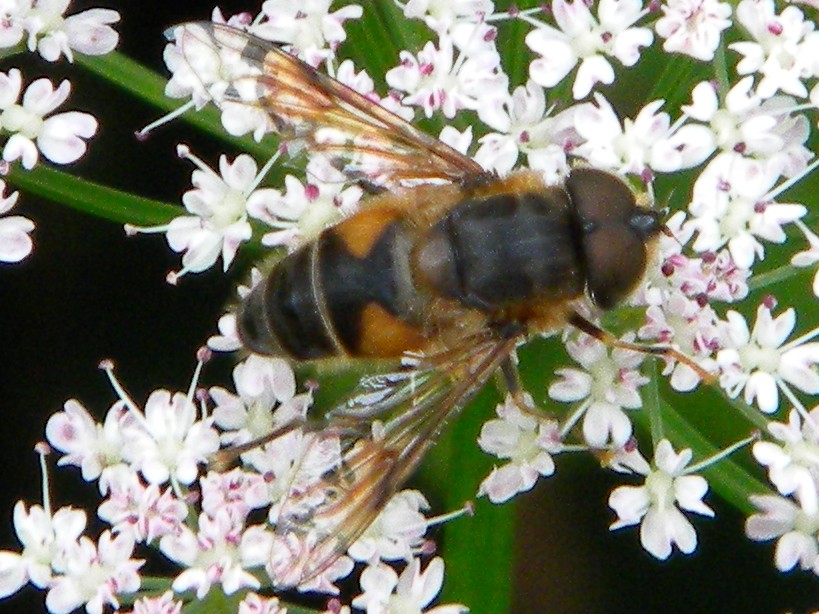 Order Diptera (true flies): Family Syrphidae (hoverflies). Hillside House garden, on ragwort flowers etc. Many July 2021. |
| Episyrphus balteatus (“marmalade hoverfly”) | Order Diptera (true flies): Family Syrphidae (hoverflies). Abundant in Hillside House garden, on ragwort, thistles etc. |
| Syritta pipiens (thick-legged hoverfly) | Order Diptera (true flies). (Tentative identification 13/08/2016). Numerous on burdock in summer 2016. Behaviour reminiscent of solitary wasp. |
| Conops quadrifasciatus | Order Diptera (true flies): Family Conopidae (adults are wasp or bee mimics, larvae are internal parasites of bees and wasps). Recorded several times in 2024 on Hillside House plot, on ragwort, thistles etc. |
| Tetanocera elata | Order Diptera (true flies): Family Sciomyzidae (marsh flies). Larvae are parasites of slugs and snails; adults live in damp places (Chinery). Recorded several times in 2024 on Hillside House plot along the edge of the meadow. |
| Loxocera albiseta (rust fly) | Order Diptera (true flies): Family Psilidae (rust flies). Present on low vegetation Hillside House 2024. Tentative identification of species from e.g. NatureSpot images. Chinery says rust fly larvae feed on plants, an important species being carrot-fly Psila rosae. |
| Tephritis bardanae | Order Diptera (true flies): Family Tephritidae (fruit flies). (Tentative identification: better pictures of wing patterns needed.) Common at Hillside House on burdock plants when green, less so after plants start to dry out. |
| Tachina fera | Order Diptera (true flies): Family Tachinidae. Occurs on thistles, ragwort etc in the summer at Hillside House. |
| Lucilia sp (greenbottle) | Order Diptera (true flies): Family Calliphoridae (blow-flies). Lucilia species are similar and require expert identification. At least one species was present on low vegetation at Hillside House during summer 2024. |
| Pollenia sp (cluster-fly) | Order Diptera (true flies): Family Calliphoridae (blow-flies). Several Pollenia cluster-fly species occur in Britain and they can be separated only on fine details. Many were present on days in August or September in 2024. In 2023 hundreds collected on the chimney stack at Hillside House. |
| Sarcophaga carnaria | Order Diptera (true flies): Family Calliphoridae (blow-flies). A large blow-fly often encountered on low vegetation on the Hillside House plot. |
| Graphomya granulata | Order Diptera (true flies): Family Muscidae. On low vegetation during summer 2024. |
| Scathophaga stercoraria (yellow dung-fly) | Order Diptera (true flies): Family Muscidae. On cowpats on grazing adjacent to the Hillside House plot. |
| Mesembrina meridiana (noon fly) | Order Diptera (true flies): Family Muscidae. On low vegetation during summer 2024, frequently encountered. |
| Nematus septentrionalis (hazel sawfly) | Hymenoptera (Symphyta, Tenthredinidae, Nematinae). Also listed under the names Craesus septentrionalis or Croesus septentrionalis. Probably this species, from pictures on the web, e.g. https://www.sawflies.org.uk/craesus-septentrionalis/. Several (30+) stripping leaves of an alder on the meadow, June 2016. |
| Eutomostethus ephippium (alder sawfly) | Hymenoptera (Symphyta, Tenthredinidae, Blennocampinae). On reeds July 2024 near Carr Stream. |
| Macrophya montana | 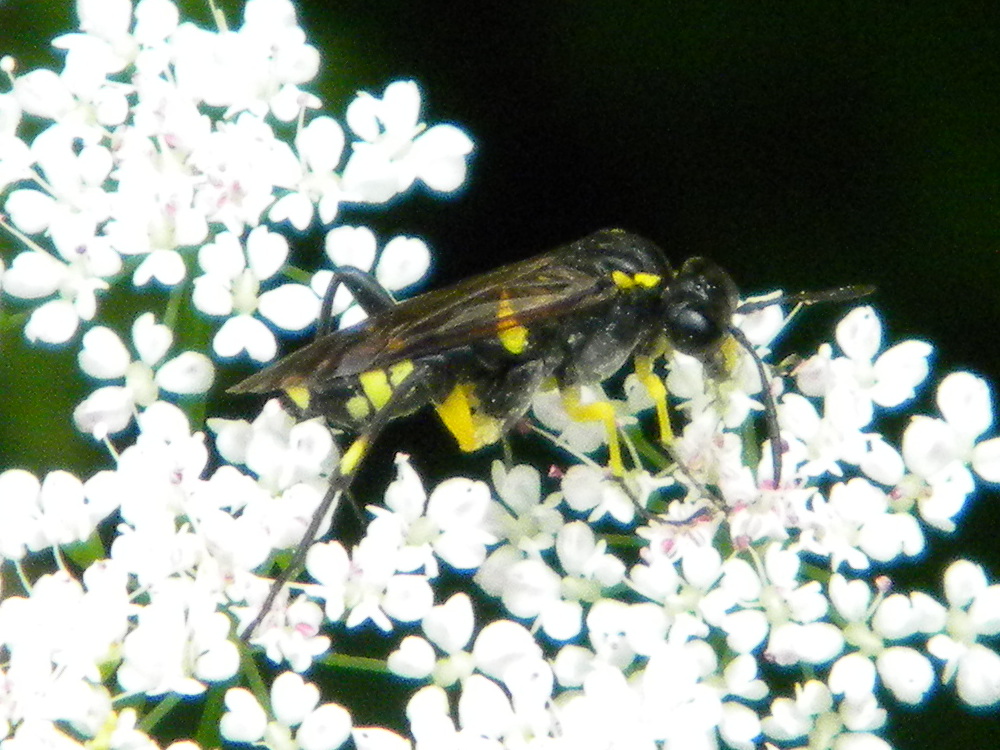 Hymenoptera (Symphyta, Tenthredinidae). On ground elder by the laurel hedge Hillside House June 2024. |
| Diprion pini (pine sawfly) | 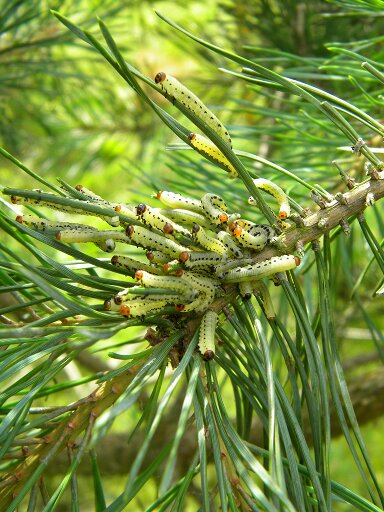 Order Hymenoptera: (Symphyta, Diprionidae). Larvae on Scots pine by shed, 2016. |
| Rhogogaster viridis (?) (sawfly) | Hymenoptera (Symphyta). At least 1 on nettles by box tree edge of plot 01/06/2019. |
| Gasteruption jaculator | Hymenoptera (Gasteruptidae). Parasitoid wasp hanging around the tunnels of other wasps, possibly also interested in spiders. |
| Ichneumon suspiciosus | Hymenoptera (Ichneumonidae). In the kitchen of Hillside House several times in 2015. |
| Amblyteles armatorius | Hymenoptera (Ichneumonidae). Identified from plate 38 in Chinery, and google images. On the meadow, in brambles, August 2016. In yew hedge near big oak, June 2020. |
| Chrysis ignita (ruby-tailed wasp) | Order Hymenoptera: Family Chrysididae. Present from 2016 onwards, probably this species but there are several 'ruby-tailed wasps'. |
| Lasius flavus (yellow meadow ant) | Order Hymenoptera: Family Formicidae. By 2024 or earlier, mounds were becoming obvious on the grassy area south of main pond. This area is not cut with heavy machinery now. |
| Lasius niger (black ant) | Order Hymenoptera: Family Formicidae. Species uncertain but likely to be L. niger. Colonies make nests underground below bare surfaces near Hillside House and emerge for copulation flights on warm summer days. |
| Anoplius viaticus | Order Hymenoptera: Family Pompilidae (spider-hunting wasps). Probably this species. One hauling a smallish spider (perhaps Trochosa sp.) up the flints on the bank of the front border, 27/08/2016. |
| Mellinus arvensis (Field digger wasp) | Order Hymenoptera: Family Sphecidae. Associated with Cistus plants and the flint and soil bank of the front border. By 2017 apparently becoming quite numerous -- up to about 10 to be seen in this area. |
| Ectemnius sp. | Hymenoptera (Sphecidae). Possible identification. Solitary wasp using larger pre-drilled tunnels in one of the willow logs in the log-stack constructed in March 2016. Probably the same species has appeared near the shed in 2024. |
| Pemphredon lugubris | Order Hymenoptera: Family Sphecidae. Tentative identification. Solitary wasp occupying tunnels in mainly willow logs in the log-stack constructed in March 2016. |
| Argogorytes mystaceus | Order Hymenoptera: Family Crabronidae (sand-wasps). On the western boundary hedge (WBH) 2024-06-07. Identified by Tim Strudwick from image DSCN3623.JPG. Record accepted by irecord (Stuart Roberts). Also possible identification: in Hillside House kitchen 2019-06-01. |
| Ancistrocerus sp. | Hymenoptera (Vespidae). Usually present on structural timber on the north end of the shed, also on the laurel hedge. During 2015, seen up to the end of September. 2021 -- 5+ in August. |
| Ancistrocerus sp. |  Hymenoptera (Vespidae). Larger than wasps recorded on or round the shed. Species unknown but likely genus identified by Mike Crawley of BWARS. One repeatedly visiting lower parts of plastic window frame June 2020. |
| Polistes sp. (paper wasp) | Hymenoptera (Vespidae). Species not known but perhaps this genus from comparison with photos on the web. Yellowish antennae and legs. Near sea buckthorn plants July 2016. [One at Ilketshall St Andrew summer 2023 -- characteristic banding on gaster.] P. dominula has occurred in a few places in Thames estuary area. |
| Vespula vulgaris (common wasp) |  Hymenoptera (Vespinae). Reasonably common near Hillside House, probably this species. Queens often found in log-stacks during winter. Pictured is a nest found in the shed in winter 2015/16 that may be of this species. |
| Vespa crabro (hornet) | Hymenoptera (Vespinae). Present erratically through summer in most years. |
| Hylaeus sp (yellow-faced bee) | Hymenoptera: Family Colletidae (plasterer bees). Species unknown. Odd records through June and July 2024. |
| Apis mellifera (honeybee) |  Hymenoptera (Apoidea, Apidae, eusocial bees). Adopted a tit nestbox on a willow tree by the pond 2015. After the same box was cleaned out in the early part of the year, a new colony formed in 2017. The same box was again in use by honeybees during 2019. |
| Bombus lucorum (white-tailed bumblebee) | Hymenoptera (Apoidea, Apidae, eusocial bees). Present in summer months, photos needed. |
| Bombus lapidarius (red-tailed bumblebee) | Order Hymenoptera (Apoidea, Apidae, eusocial bees). One of the more numerous Bombus species on the plot, to be seen from March or April until about August. |
| Bombus terrestris (buff-tailed bumblebee) | Order Hymenoptera (Apoidea, Apidae, eusocial bees). One of the more numerous Bombus species on the plot, to be seen from March or April through to the autumn. |
| Bombus pascuorum | Order Hymenoptera (Apoidea, Apidae, eusocial bees). Previously named B. agrorum. On garden plants (especially lavendar, burdock etc) 2015 onwards. One of the more numerous Bombus species on the plot, to be seen from March or April through to the autumn. |
| Bombus pratorum | Order Hymenoptera (Apoidea, Apidae, eusocial bees). Early or garden bumblebee.. Image is on Myosotis plants by main pond but this species was also seen in several places round the plot in 2024. |
| Bombus hypnorum (tree bumblebee) | Order Hymenoptera (Apoidea, Apidae, eusocial bees). Tree bumblebee. A colony occupied a tit nestbox on the big oak 2017. Apparently first recorded in UK as recently as 2001. One of the invertebrates increasing in Britain probably owing to climate change. |
| Bombus vestalis (cuckoo bumblebee) | Order Hymenoptera (Apoidea, Apidae, eusocial bees). Several on thistles July 2021. Identity suggested by expert, though image indistinct. |
| Anthophora plumipes | Order Hymenoptera (Apidae). Perhaps this species, if so a female, on comfrey several times May 2019, under the pines. All black, yellow or orange on hind legs. |
| Andrena cineraria (ashy mining bee) | Order Hymenoptera (Andrenidae). On or in ground by shed 2019-04-26. Identification using pdf file by Marc Calton. Seen in also subsequent years in same area. |
| Osmia bicornis (red mason bee) | Order Hymenoptera (Megachilidae). Formerly O. rufa. On and in the timbers of the shed April 2019. Also in subsequent years. |
| Megachile sp. (leaf-cutter bee) | Order Hymenoptera: Megachilidae. Creating several cells in holes drilled for the purpose in the log-stack built 2016. Perhaps M. centuncularis. Several on thistles (mainly spear thistle) between shed and main pond July and August 2019. Old sycamore stump, very close by, has holes drilled to attract mining or mason bees. Something is eating holes in the leaves of ash and hornbeam trees quite close by, could be this species. |
| Unidentified bee | Order Hymenoptera. In Hillside House kitchen May 2019 and other years. Better images required. |
| Coelioxys sp. (sharp-tailed bee) | Order Hymenoptera: Family Megachilidae. A brood parasite of leaf-cutter bees. On shed 2024. |
| Carabus violaceus (violet ground beetle) | 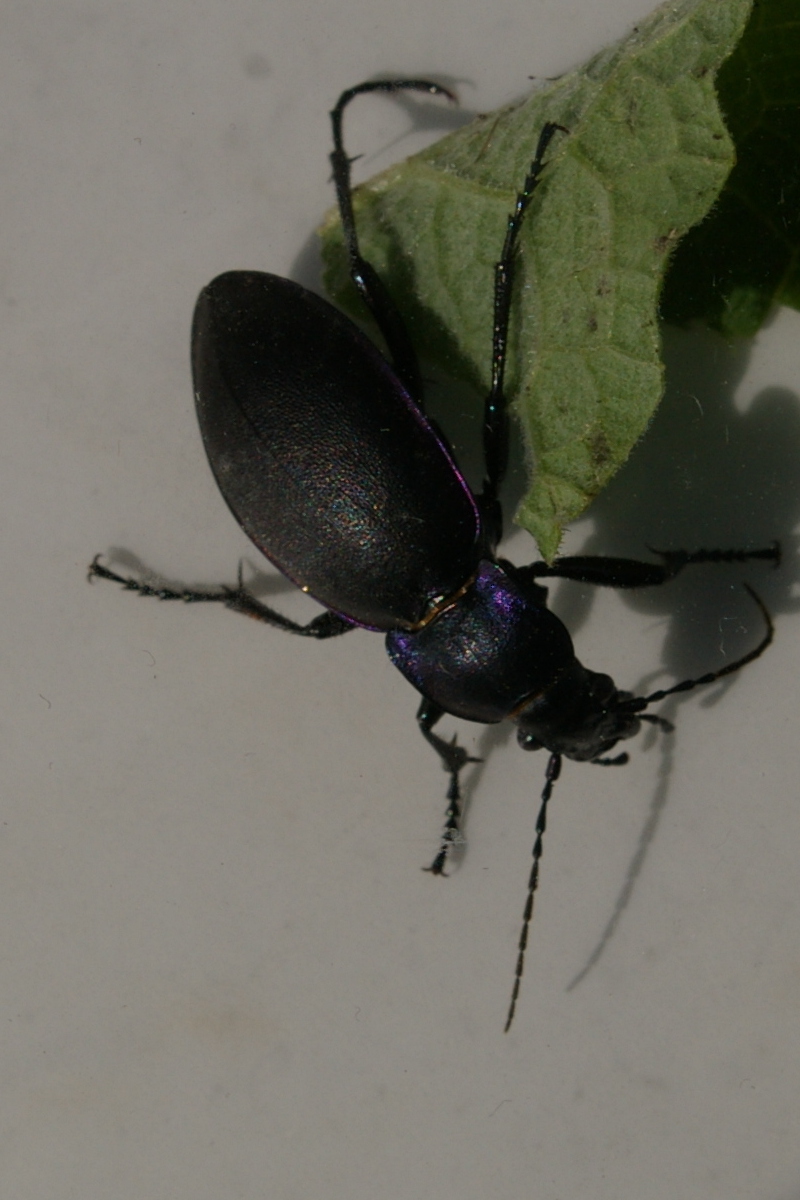 Order Coleoptera: Carabidae. One on patio 2021-09-15, identified by comparison with pictures on UK Beetles. Record submitted to iRecord. Adult in trailer on poplar planting area 2019-08-22 (or 2019-08-20), found during maintenance work. |
| Carabus granulatus (ground beetle) | Order Coleoptera: Carabidae. In shed at Hillside House, date approx 2019-10-08 (plus or minus a week). Identified by rough ('granular') upper side of elytra. |
| Harpalus affinis | Order Coleoptera: Carabidae. (Tentative identification, a common species in Britain and Ireland). Approx 10-12mm in length, often found in seed-heads of creeping and spear thistles on the grassy area near big oak. |
| Patrobus atrorufus | Order Coleoptera: Family Carabidae (ground-beetles). (Tentative identification: better pictures needed). On stems of umbellifer (hogweed) 2024-08-17, also probably same species on other days. |
| Necrophorus vespilloides or N. investigator (sexton beetle) | Order Coleoptera: Silphidae. Several along the MNW edge track on the meadow 2017. |
| Oiceoptoma thoracicum (burying beetle) | Order Coleoptera: Silphidae. May 2018 -- at least one under and round carcass of dead male greenfinch, along recently planted section of yew hedge by box tree, immediately west of Hillside House kitchen. Approx 18 mm length, thorax earth-brown, elytra ridged and blackish, abdomen extending beyond ends of elytra. Website naturespot indicates quite a few (12-15) squares in East Anglia where this species has been recorded. Naturespot says that adults and larvae do not actually eat the carcass remains but instead the larvae of other insects that are themselves feeding on remains. |
| Dorcus parallelopipedus (lesser stag beetle) | 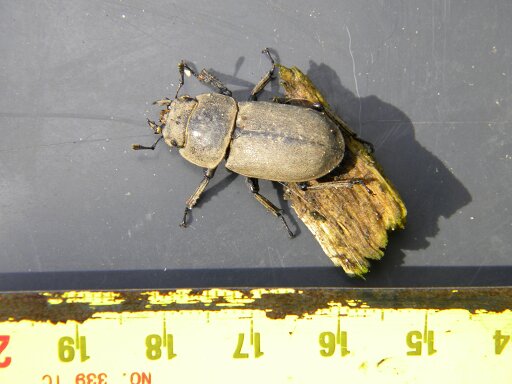 Order Coleoptera (Lucanidae). One rescued from a drain gulley 2017. Also found inside dead ash cord. Picture shows crooked antennae, which Chinery (1973) says is characteristic of Lucanidae. |
| Sinodendron cylindricum (Rhinoceros Stag Beetle) | Order Coleoptera (Lucanidae). Found by Linda Losito August 2021, exact location not known. |
| Platycis minutus | Order Coleoptera (Lycidae). Found by Linda Losito August 2021, exact location not known. |
| Melolontha melolontha (cockchafer) | Order Coleoptera (Scarabeidae). Apparently quite numerous round Hillside House garden in 2017. |
| Rhagonycha fulva (soldier beetle) | Order Coleoptera (Cantharidae). Common on ragwort etc, Hillside House garden. |
| Anthocomus rufus | Order Coleoptera: Family Malachiidae. Found in at least two places on the meadow in 2024, on reed leaves and similar low vegetation. Many thanks to Sam Amy and Martin Harvey at UKCEH for identifying these beetles. |
| Attagenus pellio (two-spotted carpet beetle) | Order Coleoptera (Dermestidae, larder beetles). Inside Hillside House. |
| Pyrochroa serraticornis (red-headed cardinal beetle) |  Order Coleoptera: Family Pyrochroidae. Various places close to Hillside House, often on umbellifer flowers. |
| Oedemera nobilis | Order Coleoptera: Family Oedemeridae. Often common on umbellifer flowers on Hillside House plot. |
| Harmonia axyridis (harlequin ladybird) | Order Coleoptera: Family Coccinellidae (ladybirds). On wall of Hillside House August 2024. |
| Strictoleptura rubra (longhorn beetle) | Order Coleoptera (Cerambycidae). One on thistles by big oak, 2020-07-26. Several near Hillside House August 2017, one found dead in water. |
| Agapanthia villosoviridescens (longhorn beetle) | Order Coleoptera (Cerambycidae). On meadow 2020-06-24. One on burdock and other plants, grassy area just north of shed 2019-06-24. Another record on spear thistle 2019-07-19. Records also in 2021. Chinery (1973) indicates this species was at the time only rarely recorded in Britain, but modern distribution maps now show an extensive range in south and eastern England up to Yorkshire. Range extension is presumably related to climate change. |
| Leptura quadrifasciata (longhorn beetle) | Order Coleoptera: Cerambycidae. (Almost certainly this species) One on the crown-lowered weeping willow by main pond, 2019-08-23. A striking longhorn beetle. Length 20mm approx, mainly black, long, non-clubbed antennae with brownish ends, elytra with 4 almost equispaced ochre bands (pattern recalling sexton beetles but more bands). Distribution map on naturespot shows a few squares in Norfolk, especially in Breckland. |
| Rutpela maculata (longhorn beetle) | Order Coleoptera (Cerambycidae). This species seems to be present most years at Hillside House. Several on burdock and thistles July 2021. Banding less strikingly even than Leptura. Record submitted to iRecord. Two other records on NBN Atlas near South Raynham. |
| Chrysolina americana (rosemary beetle) |  Order Coleoptera (Chrysomelidae). At least two on the rosemary bush by the patio, Hillside House 2021-09-10, then 6+ on 2021-09-18. Website UK Beetles indicates that this species is highly distinctive and only likely to be confused with C. cerealis (which occurs only on Mount Snowdon!). Record submitted to iRecord. |
| Phyllobius pomaceus (green nettle weevil) | Order Coleoptera: Family Curculionidae. Found on various occasions in June and July 2024 on nettles near Hillside House. |
